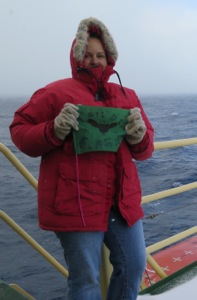Thar she blows, my first iceberg!
Location: Long -54 degrees 1.84 Lat -38 degrees 42.3
Temp: -1.6C
Windchill: -18C
Today started like any other, a bit anticlimactic as we are still transiting. In case I have forgotten to explain; transiting is basically traveling from one location to another, and in our case we have been traveling since Monday to reach our first science location which is Bird Island off the western tip of South Georgia.
My mornings are usually spent talking with scientists, getting a better feel for the science of this expedition: GPS, Seismic, Multi-beam and the echo sounder, all of which are fairly new to me. And then...wait for it...I looked out the starboard port hole and there it was, my first ice berg.
 My first iceberg off the starboard side. In a word magnificent.
My first iceberg off the starboard side. In a word magnificent.
Within seconds I grabbed my sun glasses, and headed up the five flights of stairs to get a glimpse from the bridge. In a word, magnificent. A glorious tabular ice shelf, floating by.
 A close up showing some of the visible definition.
A close up showing some of the visible definition.
 Yes another iceberg, but I am totally enamored by their majesty.
Yes another iceberg, but I am totally enamored by their majesty.
As you can see through the pictures, I was enamored by the ice bergs, and as a whole the entire day was a wonderfully cool and chilly, we even started the morning with snow on the deck.
 Thanks to Cromer Middle School for following along, Maybe by having your flag in the snow we will have a great snow winter at home this year!
Thanks to Cromer Middle School for following along, Maybe by having your flag in the snow we will have a great snow winter at home this year!
 Thank you Holden 5th Grade Eagles for following along on our expedition!
Thank you Holden 5th Grade Eagles for following along on our expedition!
After all our iceberg gawking and snow play it was time for science. Tomorrow we will arrive at South Georgia and Bird Island. The GPS team is getting ready to set up the first GPS unit. ( a total of three for the entire research cruise) Bob and Nico are the leads and tomorrow my journal will be all about their work and its importance to looking at the movement of different land masses.
 Nico checking all the GPS equipment prior to tomorrows first day of official science.
Nico checking all the GPS equipment prior to tomorrows first day of official science.
Bird Island and all of South Georgia is a very unique ecosystem, and with invasive species many indigenous plants and animals are at risk. Each person going ashore has had their clothing checked for any plant matter, seeds, any hangers on that might contaminate the existing ecosystem. The government of South Georgia is working diligently to ensure the integrity of their ecosystems.
 All clothes going ashore need to be checked for any foreign invader species.
All clothes going ashore need to be checked for any foreign invader species.
And as we end another day I think upon tomorrow with excitement: land and the possibility of going ashore.


Comments